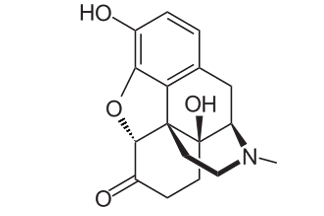Oxymorphone
Oxymorphone, a semi-synthetic opioid analgesic 10 times more potent than morphine, is used in the treatment of moderate to severe pain. It is also sometimes used in anesthesia.
Oxymorphone was first developed in Germany around 1914, but was not introduced to the United States market until January 1959. In the United States, oxymorphone was available as tablets under the trade name 'Numorphan' until being discontinued in the 1970s due to the popularity of the pills among opioid addicts. In the IV drug using community, the Numorphan 10 mg instant-release tablet was one of the most sought-after and well-regarded opioids. The tablets, popularly known as "blues" for the light blue color, contained very few insoluble binders- making them easy to prepare for injection and extremely potent when used intravenously.
In 2006, both immediate-release and extended-release oxymorphone tablets were introduced to the North American market under the name 'Opana'. In 2012, Endo Pharmaceuticals released a new formulation for Opana ER tablets that have a new time-release mechanism. The old time-release mechanism could be defeated simply by crushing the tablet. This new formulation for the extended-release tablets, which is similar to the new OxyContin formulation, will be harder to be misused or abused by addicts.
Brand Names
Opana, Numorphan
Street Names
blues, biscuits, octagons, stop signs
Formulations
- Opana - tablet, oxymorphone hydrochloride (HCl): 5 mg, 10 mg
- Opana ER - tablet, oxymorphone HCl extended-release: 5 mg, 7.5 mg, 10 mg, 15 mg, 20 mg, 30 mg, 40 mg
Medical Uses
- relief of moderate to severe pain
- preoperatively to alleviate apprehension
- to maintain anesthesia
Route of Administration
intravenous (IV), intramuscular (IM), subcutaneous (SC), oral, rectal, insufflation (snorting)
Half-life
7-9 h
Medical Dosage
pain relief: 1 mg intravenous (IV) every 4-6 h; 5 mg rectal (suppository) every 4-6 h
Legality
- Oxymorphone is a Schedule II drug in the United States.
- Oxymorphone is a Schedule I drug in Canada.
Images
References
- Sinatra RS, Jahr JS, Watkins-Pitchford JM. Oxymorphone extended-release (Chapter 25) in: The Essence of Analgesia and Analgesics. (MA, USA: Cambridge University Press, 2010)
- Schumacher MA, Basbaum AI, Way WL, Opioid Analgesics & Antagonists (Chapter 31) in: Basic and Clinical Pharmacology. 12e. Katzung BG, Masters SB, Trevor AJ (Editors). McGraw-Hill / Lange, 2012.
- Clinical Practice Guideline for Management of Opioid Therapy for Chronic Pain. United States Department of Veterans Affairs / Department of Defense, May 2010. [PDF]
- Controlled Substances - Alphabetical Order. DEA Office of Diversion Control, May 2013. [PDF]
- Controlled Drugs and Substances Act. Minister of Justice, Canada, Nov 2012. [PDF]
Related Pages
-
Oxymorphone Medication Identification
A list of imprints on oxymorphone medicines with images and details including dosages, manufacturer, shape, and color. -
Oxycodone
Oxycodone is a semi-synthetic opioid analgesic that is widely prescribed for the relief pain, and the drug in the popular medication OxyContin. Read about oxycodone brand names, street names, formulations, medical uses, chemistry, legality, and other information. -
Opioid Detoxification
A comparison of the different methods of opioid detoxification, looking at the medications used, tapering, and treatment after detoxification. -
Methadone Maintenance
Methadone Maintenance Treatment (MMT) has been proven to be a safe and effective treatment for opioid dependence and addiction. Read about the history of methadone and how a methadone treatment program works.
